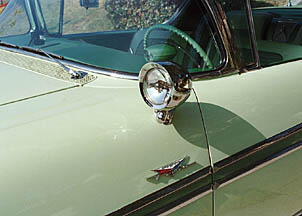| exterior details of Kris Trexler's | ||||||||||
 |
||||||||||
|
|
||||||||||
|
||||||||||
![]()
![]()

This photo shows several unique features of this car: the fender emblem "Tri Power" signifies triple two-barrel carburetors; the spotlight/mirror is controlled from inside the car; the Autronic Eye automatic headlight dimmer is visible behind the spotlight on the upper dashboard; the compass is on the center of the dashboard; and the rear seat speaker with special "Bonneville" trim is centered on the rear seat back.
![]()

![]()
The trunk is quite spacious despite the presence of the spare tire. This car is equipped with the "reel-out" trunk lamp which has a long cord that facilitates tire changes or looking under the hood at night. The automatic power antenna on the rear quarter panel is the first antenna offered on any car that raises and lowers automatically when the radio is operated - it retracts when the ignition is switched off. The "Wonderbar" radio is a Delco signal-seeking tube operated unit.

![]()
'58 Bonneville styling showcased Pontiac's attempt to move their image from a "stodgy old-man's car" to sporty rocket ship for "the up and coming sportster!" When one of these babies drives down the street, you can't miss it - "the flashiest thing on wheels!" The left back-up light swings open to access the gasoline tank filler. The pods on the bumper simulate exhaust outlets - they're fakes on the '58 Bonneville. Venting exhaust through bumper outlets was trendy for a couple of years prior to the '58 models, but the caustic exhaust was hard on the chrome plating, causing premature corrosion. Fortunately, GM and other manufacturers stopped venting exhaust through rear bumper on most 1958 cars.
![]()

1958 was the first year GM used dual headlights (the Cadillac Eldorado Brougham had them in 1957). Chrome was literally everywhere on GM's '58 models. The Bonneville and Star Chief series wore an exclusive die-cast chrome grille in 1958. The lesser Pontiacs that year used a less expensive stamped aluminum grille that was similar in appearance to the Bonneville's chrome grille.
![]()

![]()
The Bonneville's exclusive side emblem promised that this was a car for the modern era of jet aircraft and rocket ships. A Tri Power carbureted Bonneville had incredible power to match the image portrayed by the styling, however the brakes left much to be desired. Grossly underbraked, even one panic stop guaranteed smoking brake linings. The driver was lucky if his 1958 Pontiac stopped safely in hard stops. The problem was rectified in 1959 with the all new
"Wide Track" Pontiacs which featured vastly superior brakes.
![]()

engine details
